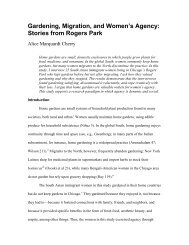research - Associated Student Government, Northwestern University
research - Associated Student Government, Northwestern University
research - Associated Student Government, Northwestern University
You also want an ePaper? Increase the reach of your titles
YUMPU automatically turns print PDFs into web optimized ePapers that Google loves.
RESEARCHof the gardening process. Everyone shares the garden’sproducts, unless they are donated to a food bank orsimilar organization. On the other end of the spectrum,gardens that have an individual gardening style designatespecific growing areas to individual gardeners.Each gardener has her own plot to grow plants and shekeeps all the products. This type of gardening style oftenrequires gardeners to apply for a plot and pay a fee ordue. Garden A has an individual gardening style. Thereare nine raised beds andone in-ground plot. Ofthese, four are designatedto a local high school andthe rest are distributed toindividuals living in theimmediate or adjacentneighborhoods. The gardenerstend to their ownbeds on their own schedules.As a result, it is rarefor gardeners to encountereach other, as reportedby an active gardener.Similarly, garden C hasmainly individual beds,with a few small communalbeds for herbs and perennials. The garden leader hasobserved that the gardeners maintain a narrow focuson their appropriated area, rather than considering themaintenance, development, and beautification of theentire site. Additionally, the leader is concerned by thelimited opportunities for the community’s involvementwith such few plots available.In contrast, gardens B, D, and E have spatial structuresthat support communal gardening. Garden B ismostly ornamental and is constructed more like a parkthan a garden, but has six small beds. Community youthtend to these beds and the rest of the space through anentrepreneurial program run by a local non-profit organization.Gardens D and E, both managed by a singledevelopment corporation, have a communal gardeningstyle even further along the spectrum. The entiregardening space in both gardens is worked by anyonewho is interested. There are specific workdays, usuallyon the weekends, and everyone—from neighbors topassersby—is invited to participate and receive a shareof the harvest.Boundaries: All of the gardens studied have boundariesbased on city lots, but the way in which they delineateand control those boundaries differ. The spectrumof this spatial construction ranges from low, picketfences without locks to high, metal gates that remainlocked. Garden B has a spatial construction akin to theformer end of the spectrum. A three-foot picket fenceruns along the two borders it shares with the sidewalk,a seven-foot wooden fence lines the back of the lot, andVOLUME 7, 2011-2012the interior side is bordered by the adjacent building.There is a small gate that remains unlocked, a purposefulmove that the leader of the organization has made toensure it is an open space for the community. Garden Chas a similar border fence without a lock.The other gardens are closer to the opposite endof the spectrum. Garden A has a low picket fence surroundingone half of the garden space that has grass,benches, and ornamental plants rather than growingplots. This portionhas neither a gate nora lock. The other halfof the space, which isthe designated growingarea, is surrounded by atall, chain-linked fenceand has a keyed lock. Atthe time of study, keysfor this lock had not yetbeen distributed to thegardeners. Gardens Dand E both have a high,black steel fence that runsalong the entire borderof the garden space. Theyare locked and are onlyopened during workdays or when other communityevents are held there. Everyone who is on the developmentcorporation’s garden committee, which is opento residents of the corporation’s housing and non-residentsalike, have a key to the garden. According to thehead of the garden committee, people can call anyoneon the garden committee and request that they open thegarden at any time.Symbolic SpaceLeadership: The leadership structure of gardens variesaccording to several attributes: number of leadershiproles, degree of formalization, and process of succession.Gardens A, B, and C all have a leader recognizedby the neighborhood as the point of contact for theirrespective gardens. In garden A, a long-term residentwho has been involved with the garden for over 10 yearsfills the leadership role. While her role is formalized,the succession of leadership is less so. The leader admitsthat she has been less active in the garden recently andwould like to pass on the leadership. Yet, one gardenercapable of playing that role who is a newer resident inthe area and considers herself the most active in thegarden, has hesitated to express her leadership interestfor fear of disrespecting the current leader’s seniority.The process of identifying and choosing a new leaderis informal, and it appears to be subject to the personalfeelings and will of the current leader and gardeners.The leader of garden B is the youth program directorand has been in his role for more than five years. HeNORTHWESTERN UNDERGRADUATE RESEARCH JOURNAL43











